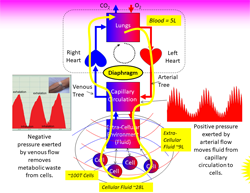

Once one learns to breathe rhythmically and more slowly with a heart-focus, heart rhythms take on a smooth, wavelike pattern as shown below. A chaotic pattern like the one below is oftentimes a reflection of emotional stress and shallow, irregular breathing. The heart’s rhythm, which is easily measured and graphed by biofeedback devices, is reflective of our emotional state. This is good for your heart! Heart rate slows, blood pressure goes down, emotions calm, and the mind slows.

Rhythmic breathing causes rhythmic heart rhythms. Do this for a few minutes or longer if you can. Hold onto that feeling of appreciation while doing heart-focused breathing. As you do this simple relaxation breathing try to add a feeling of gratitude for somebody or something in your life. As you breathe imagine your breath is flowing in and out of your heart.

This is easily done by simply breathing slowly and deeply and rhythmically. Heart coherence occurs when our breathing and heart rhythms become entrained and operate at the same frequency. Sometimes called The Zone, we feel connected to our deepest selves, to others, and to life itself. Cardiac Coherence or Heart Rate Variability (HRV) is one of the hottest areas of health and biofeedback research! Studies have found that a low Heart Rate Variability (HRV) is the single most important leading-indicator of heart disease.Ĭardiac coherence is a harmonious state where our heart, mind and body are united.


 0 kommentar(er)
0 kommentar(er)
